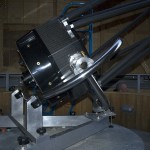From the northerly latitudes of the UK, Sagittarius is low down on the Southern horizon during the summer months. Looking towards the centre of our galaxy this region hosts some of the most stunning star fields of the night sky and is also home to some bright nebulae. Two of these are captured in this wide field image; M8, the Lagoon nebula and M20, the Triffid nebula. Also in the frame is the open cluster M21.
Whilst these objects appear close together in the sky, M20 is a foreground object with M8 considerably further away along with M21. The apparent size of the long axis of M8 is about 1.5 moon widths and the object is rather larger than the Orion nebula (60 x 40 light years).
Being a bright naked eye object (under a dark sky) means that reasonable results can be obtained from relatively short exposures. This image consists of 18 minutes of luminance frames and 9 minutes each of red, green and blue.
Observatory: Moorock, Australia
Telescope: Takahashi STL-11000M
Camera: SBIG STL-11000M




